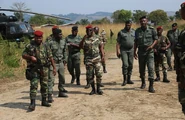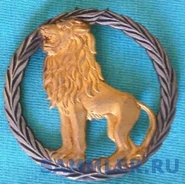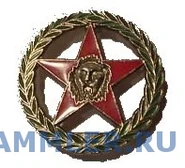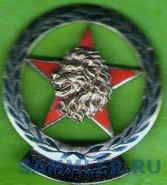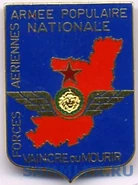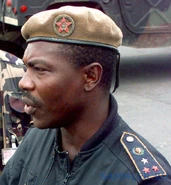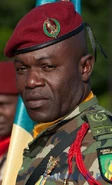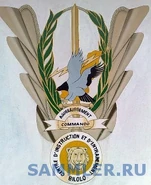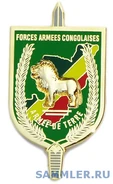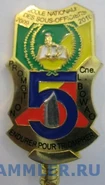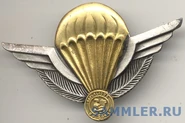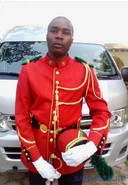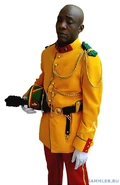Вооружённые силы Республики Конго или FAC (сокр. от Forces armées congolaises) — совокупность сухопутных войск, военно-морских сил и военно-воздушных сил, предназначенная для защиты населения, государственного строя и территориальной целостности Республики Конго.
История[]
The former French colony of Middle Congo attained independence in 1960, styling itself Congo; it is often referred to as Congo— Brazzaville. Its history since independence has been turbulent and confusing, the mixture of ethnic, political and armed forces' rivalries being peculiarly complex. At independence the government was headed by the Abbe Youlou — pro-French and right wing, from the centre of the country. His government fell in 1963; strikes and riots led to his downfall. Although French troops were flown in to protect lives and property, the French did not seek to perpetuate the Abbe's regime. He was succeeded by President Massemba-Debat — moderate left, also from the centre of the country — at the head of a government which included non-political soldiers and a number of left-wing socialists. This government moved rapidly leftwards, the more moderate ministers being replaced and an armed youth movement created; an attempt by the army to overthrow the government and destroy the youth movement in 1966 was suppressed by 200 Cuban troops of another body — a newly formed people's militia. In 1968 — 9 the country entered a period of turmoil: Massemba-Debat first dissolved the legislature, next a military coup under Captains Ngouabi and Raoul took place, then for a brief period Massemba-Debat and the army attempted to govern jointly though a larger National Revolutionary Council. This failed and Massemba-Debat resigned while the army attacked and destroyed the People's Militia and armed youth movement supporters in a 2 day engagement. Finally within the army. Captain Ngouabi emerged as the dominant figure, his popularity being based on support from northern Mbochi Kouyou soldiers, the majority group in the army. Ngouabi remained Head of State until 1977; a Kouyou, representing northern interests, he met with increasing opposition from the south and centre expressed both in conservative and extreme-left political views. Lieutenant A. Diawara, who led an insurrectionary movement from 1972 until his death in 1973, was a Lari from the geographical centre of the territory, but of extreme-left ideology. Other plots and abortive coups were also reported in this period. Events came to a head in March, 1977 when Ngouabi made a rough attempt to broaden the basis of his government and liberalise the regime. In a confused and violent reaction by several groups of officers, Ngouabi was killed: the blame was laid upon the luckless Massemba-Debat who was subsequently executed. The new regime is headed by another junior officer, J. Yhombi-Opango, and seems to be continuing the same strange mixture of revolutionary Marxist rhetoric and growing links with French and American capital, only in a somewhat more organised if severe style. A very important figure is Yhombi's deputy, Denis Sassou-Ngouesso, who is said to favour closer links with the USSR; Sassou holds the Defence portfolio. Yhombi is a northerner while Sassou is not. The politics of the Congo are essentially those of three themes: north versus centre and south, free enterprise versus Marxist, and also increasingly, army versus police. None of the grouping runs parallel, and the police is additionally divided into at least two rival security departments and a border guard, and it is said that different sections of the army staff do, in practice, control different units of the army. A noteworthy feature of the Congo is that half of its population lives in towns: one-fifth of the country's population lives in Brazzaville; this and certain other historical events of the colonial period have served to produce more acute tensions amidst changing societies than elsewhere.
The army is a doubtfully loyal armed political support group for the regime in power. Its combat value in action with an enemy army would be virtually nil.
Организация[]
The Congo has been so preoccupied with its own affairs that its army has had Httle time for preparations to meet external threats. Relations with Zaire pass through phases of friendship and hostility — Zaire was alleged to have supported Diawara's 1972 rising — and the Congo River bank and land border is occasionally guarded, particularly in the Brazzaville area. Very recently the confused situation on the Cabinda border has led to some reinforcement of units in the area. In 1971 following an unsuccessful coup attempt in which many gendarmerie officers were involved, it was announced that the gendarmerie was to be dissolved, and its duties given to the army. How this has been effected in practice and the position of the new people's militia in these changed circumstances is not known.
Prior to the disbandment of the gendarmerie, the army was composed of an armoured regiment, an infantry battalion, a 'parachute commando' battalion, and small armoured car, engineer and artillery units.
Traditionally the army has been largely recruited voluntarily from northern peoples, notably the Mbochi Kouyou; the Ngouabi government generally preserved this arrangement. Nevertheless the members of the gendarmerie drafted into the army in 1971 constitute a different ethnic following — and conflicting loyalties. In the early 1960s many of the officers were southerners, chiefly Bakongo. These have now mostly been replaced by northerners. At independence France agreed to supply cadres and training staff, but these became associated with the Youlou government and no further staff were sent after his fall. The two army mutinies that occurred in the Youlou period appear to have been anti-French. One recent report suggests the arrival of a new Cuban training mission, with semi-permanent installations at the Maya Maya airfield and Pointe Noire harbour.
Вооружение[]
The tank unit possesses approximately 12 Chinese type-62 and four PT-76 tanks; there are also a small number of BRDM vehicles and 24BTR 152 APCs in service with the 'paracommando' battalion. Recent purchases include a small number of Panhard armoured cars and APCs. The artillery possesses very small numbers of 122mm and 100mm guns (Soviet) and 75mm guns (French), together with equally small numbers of 120mm mortars, some 57mm anti-tank and other smaller anti-aircraft guns (all Soviet), and a few obsolescent British 6 pounders. The Soviet equipment originated from Cuba and China rather than the USSR. The air force operates 10 obsolescent Soviet MiG-17 interceptors, seven transport aircraft and four helicopters.
Униформа[]
Как бывшая французская колония, Республика Конго ввела для своей армии униформу французского образца, с тем лишь отличием, что вместо кепи носятся стандартные фуражки и береты.
Первая эмблема конголезской армии, которую военные этой страны носили на берете и фуражке с начала и до конца 1960-х гг., представляла собой изображение льва, обрамленное венком. С 1970 г. страна стала именоваться Народной республикой и армейская символика была изменена. Новой эмблемой армии стала красная звезда с головой льва, обрамленная венком зеленого цвета. Эту эмблему носили на головных уборах, погонах и петлицах. В конце 1990-х гг. символика с красными звездами в армии Конго была отменена, и эмблемой ВС вновь стал лев в венке. В сухопутных войсках лев изображается на фоне меча, в ВМС на фоне якоря, в ВВС эмблему дополняют крылья.
Полиция также носила армейские знаки различия, и отличалась от остальной армии только бежевым цветом берета.
Галерея[]
Источники[]
- https://en.wikipedia.org/wiki/Armed_Forces_of_the_Republic_of_the_Congo
- http://www.sammler.ru/index.php?showtopic=101828&page=5
- John Keegan. World Armies. — P.148-149.
| Северная Африка: | Алжир • Египет • Ливия • Марокко • Тунис |
| Центральная Африка: | Ангола • Габон • Камерун • ДР Конго • Конго (Браззавиль) • Сан-Томе и Принсипи • ЦАР • Чад • Экваториальная Гвинея |
| Западная Африка: | Бенин • Буркина-Фасо • Гамбия • Гана • Гвинея • Гвинея-Бисау • Кабо-Верде • Кот-д’Ивуар • Либерия • Мавритания • Мали • Нигер • Нигерия • Сенегал • Сьерра-Леоне • Того |
| Восточная Африка: | Бурунди • Джибути • Замбии • Зимбабве • Кения • Руанда • Сомали • Танзания • Уганда • Эритрея • Эфипия • Южный Судан |
| Южная Африка: | Ботсвана • Коморы • Лесото • Маврикий • Мадагаскар • Малави • Мозамбик • Намибия • Свазиленд • ЮАР |


